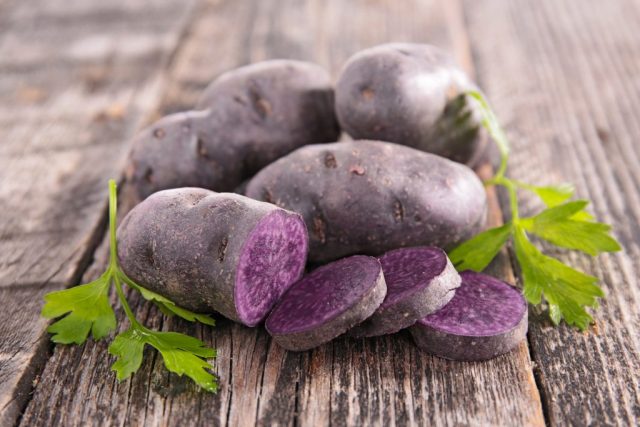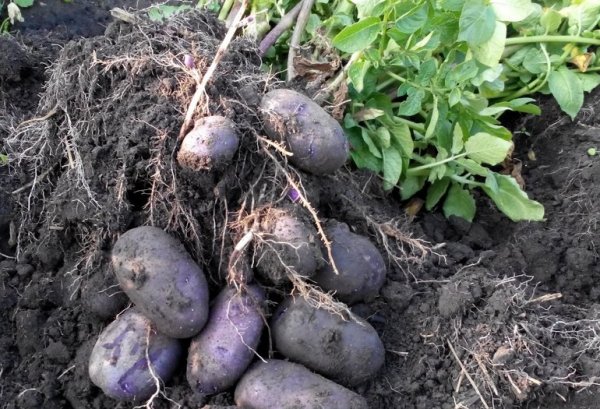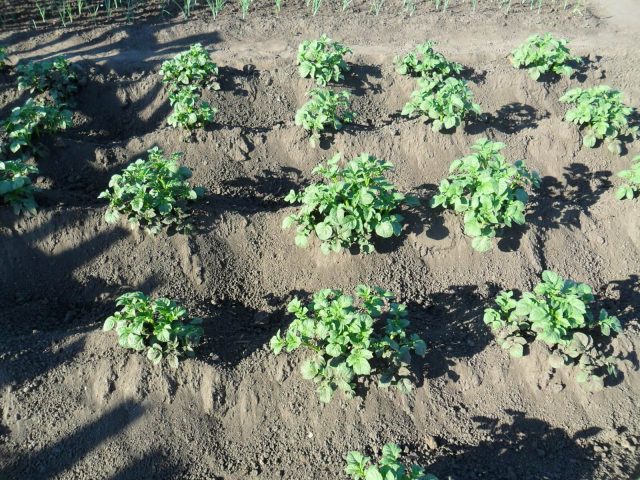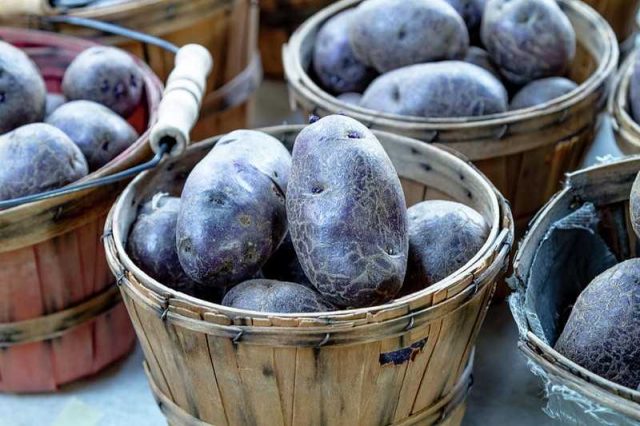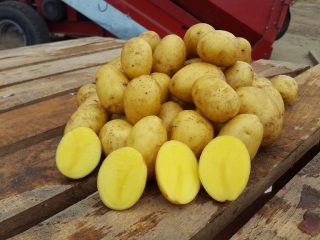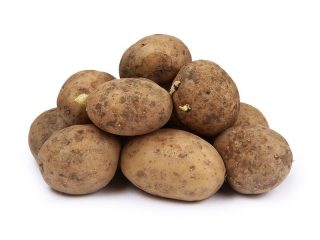Content
The description of the Gourmet potato variety should begin with its main feature - the purple color of the tubers. Moreover, an unusual color is inherent not only in the peel, but also clearly manifested in the cut. Color is not the only difference between the Gourmet and the usual potatoes. The brightly colored tubers have a unique composition and are very beneficial for the human body. The domestic variety was obtained by conventional breeding methods and does not belong to genetically modified plants.
Description of the potato variety Gourmet
Purple potatoes were obtained relatively recently and have not yet been included in the State Register, but have already spread throughout Russia. Today the variety can be found not only in private plots, but also in the fields of farms.
The Gourmet variety belongs to the medium early, the tubers ripen on average in 90 days. Excellent keeping quality will allow you to transport tubers and store them all winter.
Characteristics of Gourmet potatoes:
- the peel is dense, smooth, dark purple;
- the pulp is colored unevenly, the purple color is diluted with white blotches;
- the shape of the fruit is oval, strongly elongated;
- eyes are rare, weakly expressed;
- medium tuber weight - 90 g.
Gourmet bushes are medium-sized, not spreading, the highest stems reach 70 cm. White potato flowers are decorated with black stamens. Leaves on strong stems are small, light. An average of 10 to 14 tubers are tied under one bush.
Taste qualities of potatoes
In addition to its exotic appearance, the Gourmet is endowed with an unusual taste, which, when baked, acquires a nutty hue. They also eat raw potato pulp. Chopped tubers without heat treatment can be the basis of various salads.
The starch content of tubers is much lower than that of regular potatoes. Most often, the indicator does not exceed 13%, which makes the variety suitable for dietary nutrition. The presence of a significant number of carotenes and substances exhibiting antioxidant activity makes it possible to classify such potatoes as products useful for human health.
Gourmet is recommended to be included in the diet for diabetes, metabolic disorders, increased body weight. The rich chemical composition of potatoes is useful in the prevention of cardiovascular pathologies, hypertension, atherosclerosis, ischemic heart disease. It is useful to replace ordinary roots with purple ones with a decrease in visual acuity.
Pros and cons of Gourmet variety
Gourmet potatoes, according to the reviews of amateur gardeners and farmers, have a number of undoubted advantages:
- The ability to bear fruit well in any region suitable for potato growing.
- Preservation of presentation until spring in 90% of root crops.
- Disease resistance.
- High productivity.
Among the disadvantages, susceptibility to late blight is noted in a humid climate. This feature requires additional processing of plantings with Bordeaux mixture during prolonged rains.
Planting and caring for gourmet potatoes
Gourmet has few features in agricultural technology. One of them is heat demand.Air temperatures below + 10 ° C are detrimental to the plant. The short growing season allows the Gourmet variety to be grown in different climatic zones, but potatoes develop and bear fruit best in temperate and southern regions.
Selection and preparation of the landing site
Gourmet potatoes prefers slightly acidic soils with a loose, breathable structure. Any soil can be improved for excellent yields.
Several principles for choosing and preparing beds:
- Peaty, sandy loam and loamy soils are the best choice for the Gourmet variety. If the sand content is too high, it is required to create a fertile layer artificially, introducing humus, rotted manure into the soil.
- On heavy loams, it is important to ensure that the top layer of the soil is loose. Sand, peat, rotted leaves are brought into the beds for digging. Maintaining the topsoil in a loose state is required throughout the season; mulching does this well.
- Open, sunny areas are preferred for planting, but partial shade is possible in hot climates.
The Gourmet variety loves abundant moisture, with good watering it can bear fruit in the hottest climates. Despite this, you should not choose low-lying areas with high humidity for planting, where potatoes tend to hurt. In conditions of frequent natural precipitation, the Gourmet is best placed on slopes with a free outflow of rainwater.
Preparation of planting material
Gourmet is a young, unusual variety, the planting material of which is more expensive than the usual potatoes. If possible, you should choose large tubers, plant preferably them. Small specimens are prepared as standard, but planted with a slight thickening.
Preplant preparation of Gourmet tubers:
- selection of healthy, undamaged potatoes without spots and growths;
- dressing tubers in a solution of mineral fertilizers or Bordeaux mixture for at least 60 minutes;
- bookmark for germination in a bright room with spraying of young shoots every few days.
The appearance of strong, young shoots about 1 cm long indicates that the potatoes are ready for planting. Overgrown shoots should be shortened. Thin sprouts that appear when stored in the dark are best removed.
Landing rules
Potatoes are taken out into the open air in advance, preferably several days in advance. At temperatures above + 10 ° C and sunny weather, the tubers are heated, preventing the young shoots from drying out.
On the prepared beds, tubers are dropped to a depth of 5 to 10 cm. The planting scheme for the Gourmet variety assumes leaving a distance between the holes of about 40 cm and 60 cm between the rows. Small potatoes are planted more often, at intervals of up to 30 cm.
Watering and feeding
For Gourmet potatoes, both excess and lack of moisture are critical. In dry seasons, additional watering will be required at least 2 times during the growing season.
Watering rules for the Gourmet variety:
- from the moment of planting to the emergence of shoots, additional moisture is not required for potatoes;
- the first watering can be carried out when friendly seedlings appear;
- the second time, the plantings are abundantly moistened during flowering;
- the next watering is needed when there is insufficient precipitation during the period of mass gain by the tubers.
It is convenient to combine watering with top dressing. It is important to first moisten the soil with clean water, and then spill it with fertilizers so that the mineral compounds do not burn the tubers. It is best to feed the potatoes with superphosphate, saltpeter, urea, potassium chloride, nitrophosphate, diluted according to the instructions.
Loosening and weeding
The Gourmet variety is sensitive to the formation of a soil crust on the surface of the soil. After each watering or heavy rain, the beds should be carefully loosened. Only superficial treatment is permissible so as not to damage the roots or young tubers.
Mulching not only solves the problem of drying out the topsoil, but also saves moisture, does not allow to actively grow weeds... Weeding in such beds can be carried out less often, and after closing the tops, stop altogether. Potatoes can be mulched with cut grass or weeds without seeds.
Hilling
An important agrotechnical technique for caring for potato plantings provides additional root growth, prevents the soil and stems from drying out, and increases yields. Early hilling of Gourmet bushes can save plants from recurrent cold weather in unstable temperate climates. In this case, it is permissible to cover the sprouts with soil entirely.
The next hilling is carried out depending on the growth rate of the bushes, preferably before the onset of the flowering phase. Gourmet stems can be sprinkled with moist soil up to half of their growth.
After the formation of the plant and the setting of the potatoes, additional dusting with soil may be required. This is how they form crumbling bushes or cover the surface tubers from the sun.
Diseases and pests
The young purple variety has strong immunity to potato crayfish and scab. The variety is relatively resistant to late blight and fungal infections. However, the variety remains susceptible to viral diseases, so measures should be taken to prevent infection.
The following measures prevent diseases in Gourmet potatoes:
- timely weeding;
- destruction of harmful insects that spread viruses using modern insecticides;
- observance of crop rotation, with a regular change of crops that do not have common diseases and pests.
Spraying tubers with special preparations, for example, Prestizhitator or Prestige, also protects against wireworms and major diseases.
Potato yield
The gourmet is highly productive. With full agricultural technology, up to 15 tubers are tied under each bush. With sufficient moisture and soil fertility, one potato can grow larger than 100 g.
The total yield of the variety is higher than the average for potatoes: from 1 sq. m receive up to 4 kg. Under average conditions and lack of care, the crop is guaranteed to provide 1 kg of tubers from one bush.
Harvesting and storage
The gourmet bears excellent fruit on various soils and is able to bring early harvests, which distinguishes him favorably from other varieties. First, young potatoes can be dug up 40 days after sprouting. If the climate permits, then fully ripe potatoes can be harvested after 110 days.
On average, it takes 85-90 days for the Gourmet to fully ripen the tubers and form a dense peel. After this period, the harvested potatoes are suitable for long-term storage. The variety is distinguished by good keeping quality and in a cellar or a well-ventilated basement it is perfectly preserved until spring.
The material selected for planting should be planted immediately after collection. For this, the Gourmet tubers are kept in a lighted place (avoiding direct sunlight) for at least 10 days. Greened tubers do not germinate in winter, are not damaged by rodents, sprout quickly, and grown bushes are less sick.
Conclusion
The description of the Gourmet potato variety gives an idea of the unique properties of purple tubers. The few reviews about the culture show that domestic gardeners have not yet had time to fully appreciate its merits. Most gardeners who have tried the variety on their own plot positively assess its yield, are satisfied with the taste and dietary properties of the grown potatoes.
